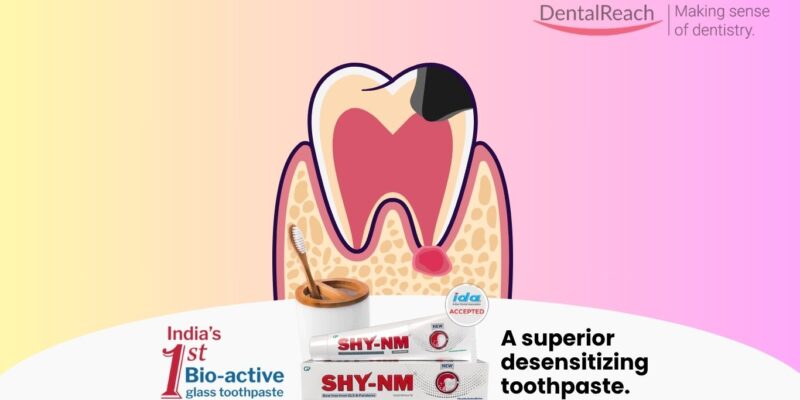Abstract
A 52 year old female patient reported to the clinic with the complaint of pain in the upper back region of her jaw since last few days. An intra-oral swelling associated with carious teeth was present. The patient was not ready for extraction, due to an impending eye surgery and was advised to go for drainage of the dental abscess, followed by dressing.
Introduction
Dental abscess is a localised collection of pus around the teeth and adjacent jaw tissue. Abscesses are the result of an infection, generally bacterial, localised in the area where the abscess forms. They are almost always accompanied by swelling and inflammation.
There are two major subtypes of dental abscess : periapical abscess and periodontal abscess.
- Periapical abscess (affecting the tooth): Periapical abscess usually occur near the apex of the tooth root. They are more common in children than adults. Individuals with poor dental hygiene are particularly at risk of periapical abscess. Damage to the enamel and dentin, and in later stages the pulp, causes an inflammatory condition known as pulpitis. Periapical abscesses are a common complication of severe, long term pulpitis. They can cause swelling in the jaw, cheeks and the floor of the mouth.
- Periodontal abscess (affecting the gums): Periodontal abscesses are more common in adults than children. They tend to originate in the alveolar bone and periodontium. Periodontal abscess may also present with a gum boil.
Signs & Symptoms of a Dental Abscess:
Dental abscess are usually painful. The pain may be present in the tooth itself, in the surrounding gum or be more generalized, including the jaw, cheeks or even neck or face, depending on the location of the abscess. The affected tooth may :
- Feel tender
- Feel loose in the jaw
- Be sensitive to heat or cold in the mouth
- Be sensitive to pressure on the tooth, or to being tapped
- Being slightly raised
Other symptoms of dental abscesses include:
- Swelling in the gums or face
- Redness of the skin over the affected part of the gingiva
- Bleeding from the gingiva
- Fever etc.
Dental examination may also reveal swelling and redness around the tooth and a fluctuant (movable) mass in the area.
Treatment of Dental Abscess
The treatment of dental abscess includes
- Incision and Drainage
- Root Canal Treatment with or without apicectomy (if tooth or teeth can be salvaged) or
- Extraction ( if tooth or teeth cannot be salvaged).
In Incision & Drainage, a small cut (or incision) is given in the abscess, and the pus which contains bacteria is drained out. The dentist may prescribe antibiotics & painkillers for a few days.
In Root Canal Treatment, the enamel, dentin and pulp is cleaned out till the periodical area. If infection is severe, a microsurgery called ‘apicectomy’ may be planned for resecting the root along with the periodical lesion.
In Extraction, the offending tooth or teeth are extracted, followed by curettage of the socket with saline or medicaments and sutures for quick healing of the site.
Case Report
A 52 year old female patient reported to the clinic with the complaint of pain in the upper back region of her jaw since last few days. Intra oral examination revealed swelling & inflammation in the posterior maxillary region with carious teeth. The patient had an impeding eye surgery and refused to undergo extraction of the carious teeth, agreeing to proceed with incision of the dental abscess.
The patient was administered a posterior superior alveolar and infraorbital nerve block . Localised infiltration was not given as swelling & inflammation was present in the gingiva. After administering of local anesthetic, 20 to 25 minutes were allowed for the anesthetic to take effect. A small incision on the dental abscess using BP blade no 11 was made. It was a wide incision parallel to the skin and was wide enough to drain the pus out.
After the pus was drain drained out, the affected area was cleaned with normal saline & povidone iodine solutione. After that a a dressing of zinc oxide eugenol was placed over the incision. The patient was told to keep the dressing in that place for as much time as possible.
After this , the patient was prescribed medications such as:
- Tab Cefpodoxime 400 once daily after food for 5 days
- Tab Metronidazole 400 mg twice daily after food for 5 days
- Combination Tab Aceclofenac, Paracetamol & serratiopeptodase twice daily after food for 5 days
- Combination Tab Trypsin – Chymotrypsin twice daily after food for 5 days &
- Tab Pantaprazole DSR once daily before food for 5 days.
The patient was advised to locally apply chlorhexidine gluconate gel over the incision area thrice daily for next 10 days.
Discussion
Incision and drainage (I&D), though not very common, is one of ways to manage a dental abscess. Its indications include:
- Fluctuant Abscesses: The presence of a clearly defined collection of pus within the soft tissues, often indicated by a soft, “pointing” swelling that is tender to the touch.
- Mid sized Abscesses: When abscesses are too large or too deep to be effectively treated with conservative measures like antibiotics and warm compresses alone.
- Spread of Infection: In cases where a periapical abscess has spread beyond the tooth and surrounding bone into the soft tissues or fascial spaces, necessitating I&D for source control.
- Pain Relief: I&D is a time-honored method for rapidly relieving the significant pain associated with dental abscesses.
The patient presented with a unique condition where she did not wish to undergo any surgical procedure prior to her upcoming eye surgery, and hence opted for management by incision and drainage.
Contraindications of I&D include:
- Large or deeper abscesses
- pulsatile masses at the site
- proximity to major blood vessels or nerves, or
- the presence of a foreign body
These are relative contraindications that require specialized surgical evaluation.
A posterior superior alveolar nerve block numbs the upper molars and the surrounding structure and area. This nerve block is usually given over the second molar. The infraorbital nerve block numbs the upper cheek, side of the nose and upper teeth. The needle is inserted below the infraorbital foramen pointing and advanced till the needle meets the maxillary bone just superior to the foramen. Care must be taken to ensure that that the needle is not inserted into the infraorbital foramen. Only 2 to 3 ml of anesthetic is administered. Complications primarily include hematoma.
It must be ensured that during I&D, all the pus containing the bacterial toxins must be drained out, after which the incision area should be irrigated with normal saline mixed with povidone iodine solution. Generally, normal saline (0.9 percent saline) and povidone iodine solution are mixed to be used as irrigating solution in oral surgery. This prevents infection in the incision site.
Zinc oxide eugenol (ZOE) dressing can be used to treat raw wounds after oral surgical procedures. ZOE dressing is made by mixing zinc oxide powder and eugenol liquid. Eugenol acts as an anti bacterial , analgesic and in low concentration can reduce inflammation too. ZOE dressing is not a replacement for bone or skin grafts. In some cases, eugenol was seen causing allergies and hypersensitivity reactions.
Limitation of I&D is recurrence. Dental abscess can re occur even after incision and drainage, if the patient doesn’t take good care of his or her oral health. Frequent dental caries, weakened immune system, dry mouth etc can add to re occurrence of dental abscess.
References
- Signs of Tooth Abscess : Stages and Treatments|Ada ( https://ada.com/conditions/dental-abscess/ )
- What’s to know about dental abscesses? Written by Tim Newman on December 4, 2017 ( https://www.medicalnewstoday.com/articles/170136#treatments )
- How To Do an Infraorbital Nerve Block, Percutaneous By Richard Pescatore,DO, Delaware division Of Public Health , Reviewed/Revised Oct 2024 , MSD Manual Professional Version (https:// www.msdmanuals.com/professional/injuries-poisoning/how-to-do-anesthesia-procedures/how-to-do-an-infraorbital-nerve-block-percutaneous )
- Zinc Oxide Eugenol Paste as a Dressing Material on Surgical Raw Wounds after Wide Excision of Oral Potentially Malignant Disorders
- A Prospective Controlled Clinical Trial By Vishal; Khaitan, Tanya¹;Prajapati,V.K. , Indian Journal of Dental Sciences 13(2):p98-102 ,Apr-Jun2021.|DOI:10.4103/IJDS.IJDS_170_20
- Neovascular Pattern in Wound Healing after Zinc Oxide and Circumstances longa Rhizome Extract Dressing Application BY Nilna Naila Faiga ¹, Priyawan Rachmadi¹,Asti Meizarini¹
- Contemp Clin Dent.2018 Sep;9( Suppl 2):S337-S341.doi : 10.4103/ccd.ccd 435 18
- Zinc Oxide -Eugenol Cement Placement ( www.columbia.edu)
- Bezawada NR, Bali S, Aggarwal P, Arora S. Periodontal dressings: A review. Santosh Univ J Health Sci 2020;6(1):5-9
- A comparison of calcium hydroxide/ iodoform paste and zinc oxide eugenol as root filling materials for pulpectomy in primary teeth : A systematic review and meta-analysis. Rahaf S Najjar, Najlaa M Alamoudi , Azza A El-Housseiny, Amani A Al Tuwirqi, Heba J Sabbagh
- Clin Exp Dent Res .2019 Mar 4; 5(3):294-310.doi:10. 1002/cre2.173





















Comments